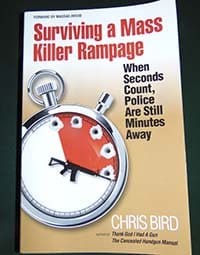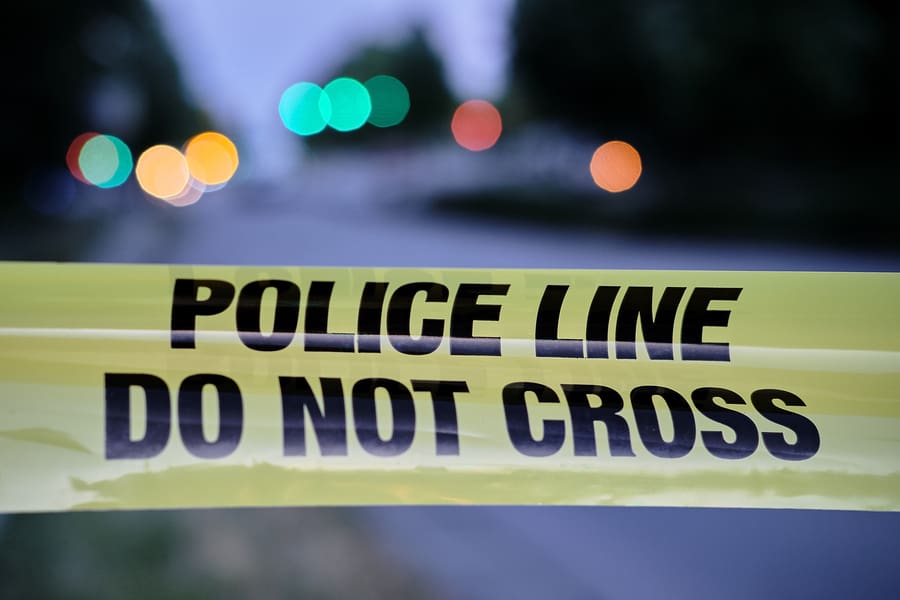
I met Chris Bird at a Gun Rights Policy Conference (GRPC). We were sitting next to each other in the front row. We’d both interviewed Vic Stacy, the hero who made hits at 57 yards at the Peach House gun fight.
Stacy shot the insane killer who was shooting at police sergeant Steven Means from behind cover. He made the shots with a 6 inch, stainless .357 magnum Colt Python. Not surprisingly, the stories we got were nearly identical. Chris published his account in one of his books, mine went on Gun Watch. Stacy’s story is one of those used in Chris’ latest book.
At the 2016 GRPC, I received Surviving a Mass Killer Rampage, published this year. The research that went into the book is outstanding. The book is extremely informative and easy to read. There are details you will not find elsewhere, unless you follow Chris’ steps and gain access to official records and interview participants. The details make the book read like an adventure novel. It’s hard to put down.
Did you know that at Virginia Tech, Air Force Cadet, Matthew La Porte, in uniform, charged the shooter, only to be shot down? He took eight bullets. La Porte received an Air Force commendation, posthumously.
Chris gives a detailed account of the Faculty Administrator Safety Training and Emergency Response (FASTER) course that is wildly popular in Ohio. The course instructs staff to be armed responders, to do triage, set priorities, and use lifesaving first aid after the threat is stopped. It’s an intense three day course. A School Resource Officer that attended an advance course made this comment:
“When I came in here, I was adamantly opposed to this. I did not believe in it; I was really, really upset by it. Now I am on board. I thought I could protect them, but now I see that I need help.”
Chris covers much more than school mass killings. He describes, in detail, the evolution of police tactics on responding to mass killer rampages. Police realize you need to go in immediately, even if you are the only officer on the scene. One officer, Justin Garner, of the Carthage, North Carolina, Police Department, did exactly that. He stopped the killing with one shot at the shotgun wielding murderer from a measured 142 feet, using a Glock .45. Garner was near simultaneously fired upon and survived two relatively minor buckshot wounds.
This is the sort of detail that Chris uses to explain the tactics needed to survive these encounters. If you’re caught in a mass killing rampage, or need to respond to one, the information may save you and others. The book is solid, factual, entertaining and extremely well written. Buy it, read it, pass it around. Give it to a school teacher or administrator who might be interested. If they read it, they will likely be the best informed staff on the subject in their school.
You can order Surviving a Mass Killer Rampage directly from Chris at Privateer Publications or from Amazon. It’s available in paperback for $22.95, or for $18.99 on Kindle.
©2016 by Dean Weingarten: Permission to share is granted when this notice is included.
Link to Gun Watch




Well, it’s a better title than “Thank God I had a Gun”
Rarely do I take a story here as gospel but you got a sale on this one. It will be here Tuesday according to Amazon. I’ll letcha know what I think probably by Thursday evening.
Subbed to hear about it.
Rule number one to survive a gunfight is to have a gun. No matter what the pols, business owners and others tell you. Have. A. Gun. Period.
142 ft., 47 yds. that’s pretty amazing. i’ve seen it done on the range in training, but while facing a guy with a shotgun?
OK, so Stacy was resting the Python on the hood of a vehicle, at 56 yards. Damn good shooting in the circumstances. I heard years ago that an FBI agent made some hits during the Miami shootout with a .38 from about 50 yds, from across a road from the main shootout. Obviously not fatal, but good shooting–using a car door as a rest from what I heard. Back in the day the FBI had quite a bit of 50 yd. shooting as part of revolver qualifying. Ya never know. Stats may be against using a handgun at such ranges, but it sure helps to be prepared for any contingency.
If nothing else your incoming rounds may distract the shooter and give someone closer a chance to make a good hit.
If you are armed with both rifle and pistol, your pistol takes up at whatever distance that your rifle leaves off (for any reason) if you cannot either break contact, or close with the enemy, and vice versa.
We were taught to engage the enemy (multiple targets) with a pistol (Beretta 92FS) at 40′ as fast as we could and still hit the targets, while we were moving to break contact or close from there. It messes with the way you shoot, and consumes ammo worse than a CA gun grab. But it is decent chaos training, and keeps you from trying to always make your shooting ‘pretty’.
Joe R.,
I am familiar with the training mindset to either close-in on the killer or break-off. I will argue that there is a third option that could be the best tactical option in many circumstances: maintain your distance and/or location while putting shots on target.
As a result, I believe training should include practicing all three actions, lest you are “programmed” to close-in or break-off at your (or other people’s) peril.
Note that Vic Stacy did exactly what I described above. The killer had a rifle and a large tree for cover; Mr. Stacy had a revolver and a car for cover. It would have reduced Mr. Stacy’s effectiveness to “break-off” or increase distance since he only had a revolver and was already over 50 yards away. And it probably would have been suicidal for Mr. Stacy to try and close-in on the killer who had excellent cover and a rifle. Instead, Mr. Stacy maintained his distance and location (behind a car) and put effective shots on target.
You only need 27 words and a gun…everything else is filler and management getting you killed.
I applaud Vic Stacy.
At 56 yards I could make that shot with a open sight rifle… but with a handgun… nope!
I always include some 50-75 yard shots in training with my handguns. Partly to show it can be done and partly because you never know. And as stated abouve, accurate cover fire might let someone else get closer.
I actually think this is a fantastic idea if you have a range that allows for it.
At one point in my life I was asked at what range I thought I could cut a vertically held cigarette in half cold-bore with my 941. I had to think about it. Finally I said 20 yards to which the people with me laughed and called bullshit. They stopped laughing when I did it.
That said, yes the gun and I were capable of that shot but under stress that would be a WHOLE different kettle of fish. In this case I drew casually and had all the time in the world to take the shot. The smoke didn’t move either. Could I pull that shot when a hostage’s life was on the line? Honestly I don’t know and I’d really rather not find out.
Your post brings up, with me at least, that I should start practicing those “shoot small, miss small” shots more. Thanks for that.
I, too, met Chris at GRPC and bought his book. I enjoyed his “The Concealed Handgun Manual”, and cited it in my book.
Haven’t had a chance to read it yet (reading “The War on Guns” by John Lott ( met him too and got a signed copy)
Mr. Bird is an excellent writer and researcher. Looking forward to this book.
Got to know Dean Weingarten at GRPC as well. A clear thinking patriot and gentleman.
Flee, hide (barricade/cover), or fight. those are your only options if you want to survive.
Freezing ( e.g. filing into a classroom, sitting on the floor, pulling the shades,turning out the lights) just gets people killed. Many schools are being trained to make their students stationary, defenseless victims.
Comments are closed.